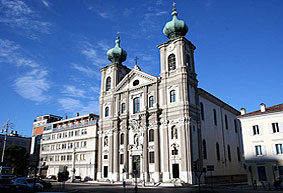


All the structures

Gorizia was severely damaged during the First World War and divided into Italian Gorizia and Yugoslavian New Gorizia (now Slovenia).
Nowadays Gorizia is once more a wonderful, culturally splendid city.
As its monuments confirm, Gorizia is a beautiful, historical city in the Friuli Venezia Giulia region. The Cathedral, one of Gorizia’s major artistic masterpieces, has undergone several reconstructions due to the serious damage it suffered during many wars. The Cathedral façade is a modern renovation, but original parts are still conserved in the interior. Some of Gorizia’s other gems are the Church of S. Ignatius, and the Coronini Castle and Villa, which houses important art collections and has a magnificent lawn.
Gorizia borders the Collio region, one of the most important wine producing areas of the Italian peninsula. A great way to visit the Collio area is to follow the ‘Wine and Cherry Road’. In spring this area is tinged with the colours of cherry blossom. The route is mostly hilly, with typical wine cellars found along it, while the higher regions offer the possibility of visiting isolated churches and castles.
Gorizia contains natural areas of true excellence, such as the Cavanata Valley Nature Reserve. The reserve is located in the municipality of Grado and features various kinds of environments: a lagoon, woods and meadows. Around two hundred species of birds can be seen in the Cavanata Valley Nature Reserve.
The Doberdo’ and Pietrarossa Lakes Regional Nature Reserve offers visitors the spectacle of two large karstic depressions, filled almost entirely by the lakes Doberdo' and Pietrarossa. The two lakes are notable for being among the few examples of karst lakes in Europe. The Foce dell’Isonzo Nature Reserve is a lagoon located along the Isonzo River and part of the municipalities of Grado, Fiumicello, Staranzano and San Canzian d'Isonzo.